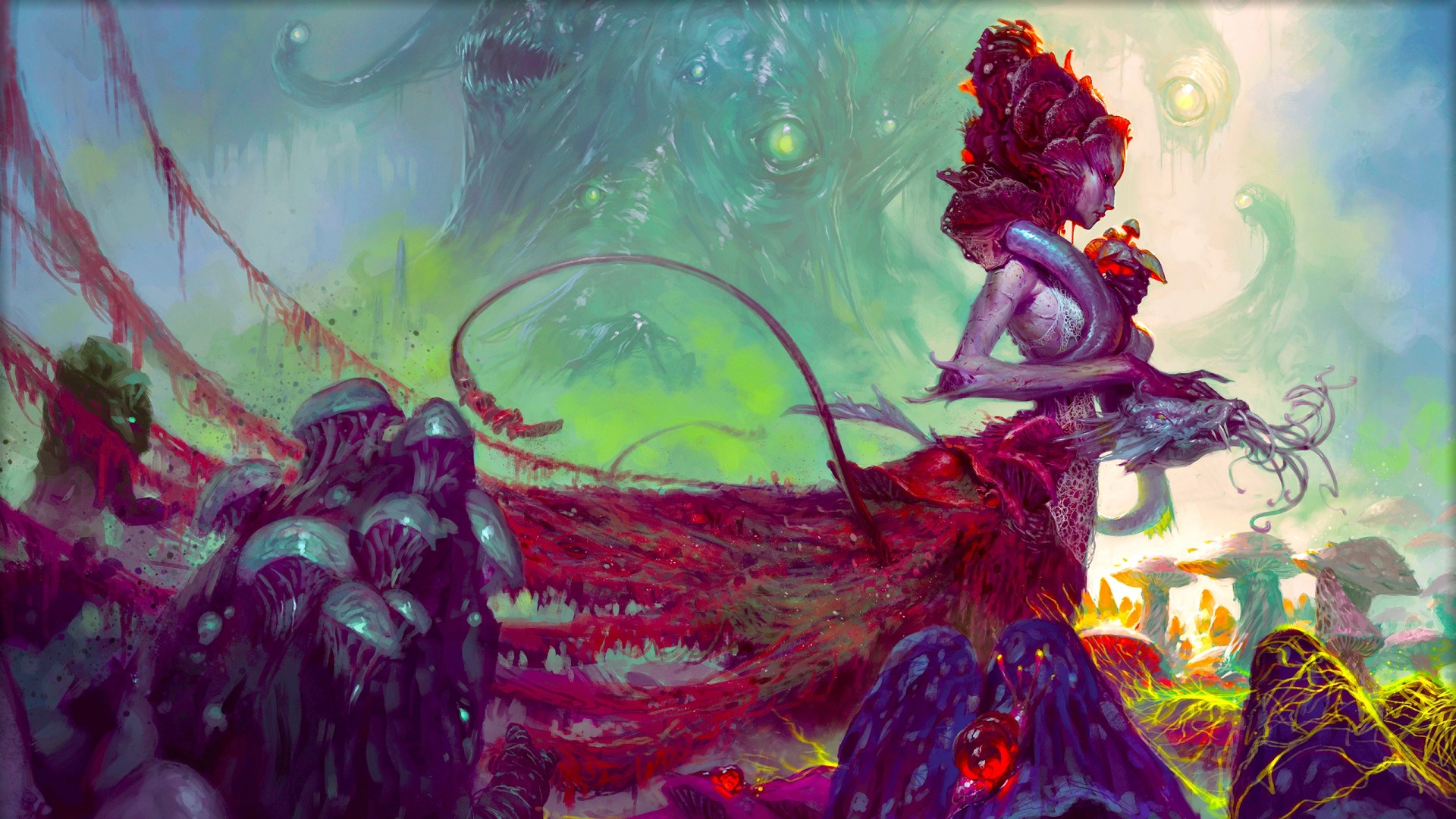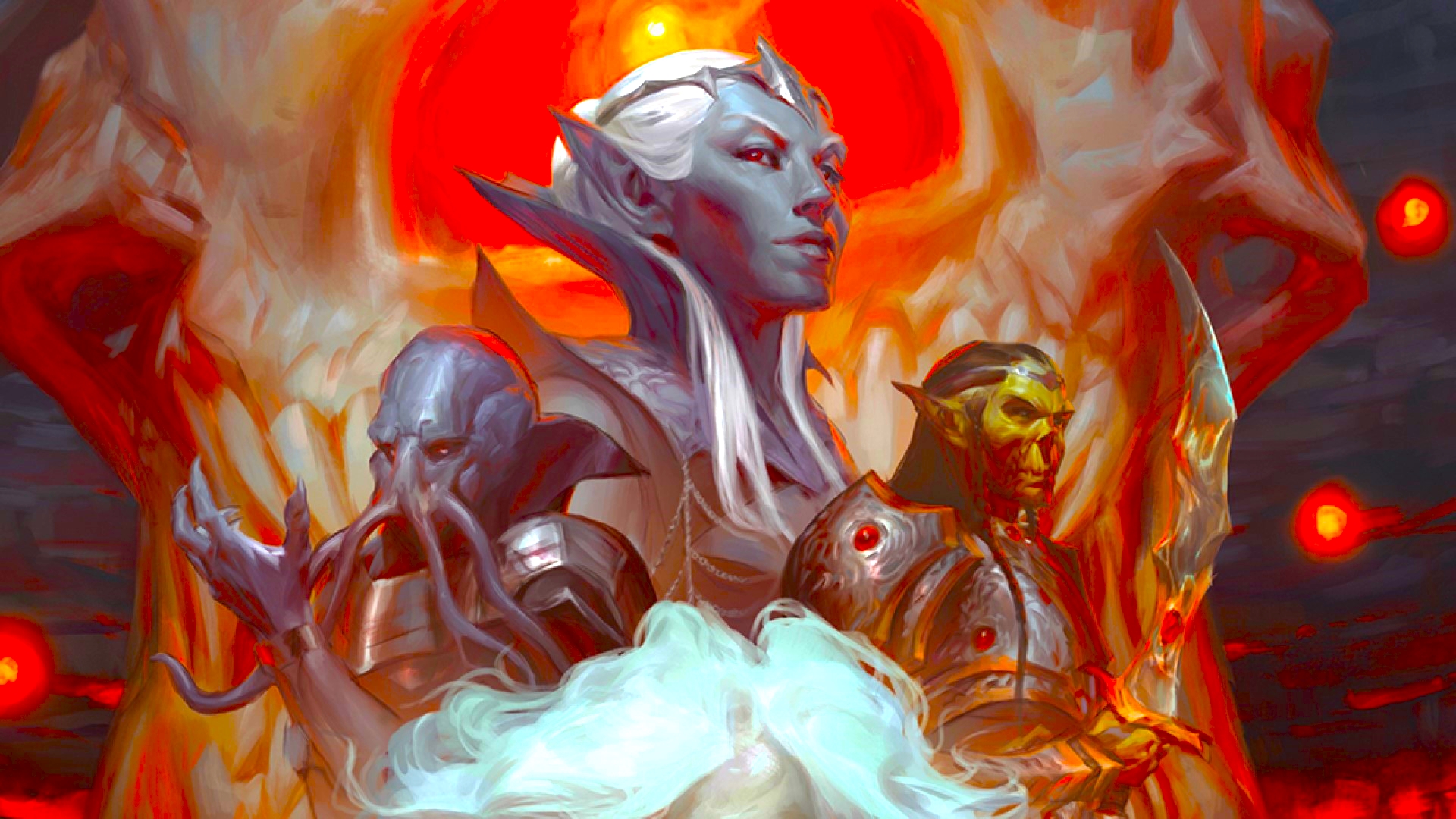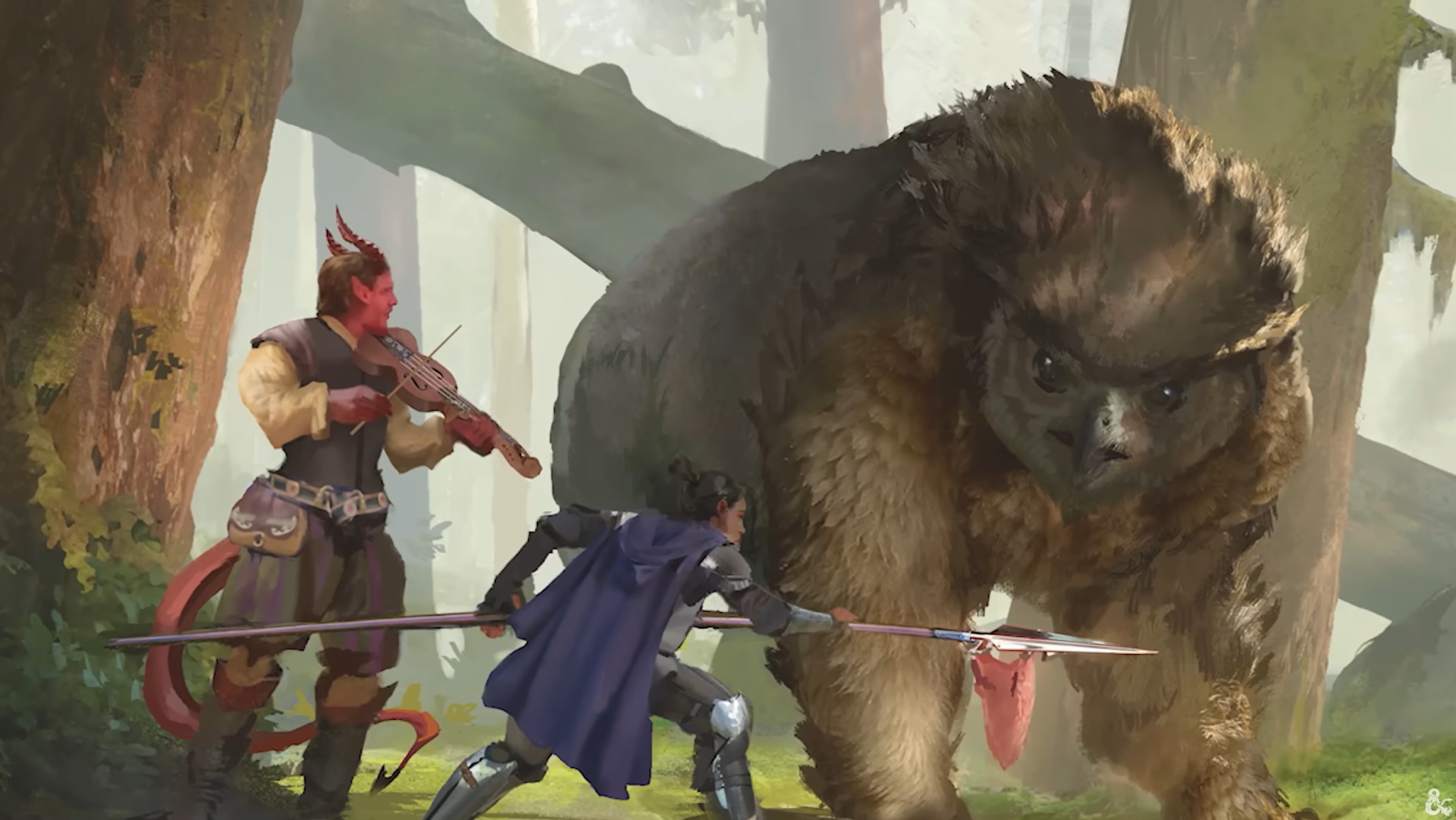Looking for some DnD monsters to populate your trap-filled dungeons, haunted forests, and deep, dank caves? You’ll find all the best 5e monsters in our guide – plus DM advice on how to run them, potential tactics and their general role in the game. We’ve organized our favorite monsters by Challenge Rating (CR), so you’ll find weak little guys at the start and endgame boss monsters at the end. Happy (player) hunting!
While you’re preparing your deadly enemies, though, make sure your players are fully equipped to build the best characters to fight ’em: our complete beginner’s guides to DnD classes and DnD races are the best place to start. Now for the beasties…
These are the best DnD monsters, in ascending order of CR:
- Mimic 5e – CR 2
- Displacer Beast – CR 3
- Owlbear – CR 3
- Black Pudding – CR 4
- Mind Flayer – CR 7
- Beholder – CR 13
- Lich – CR 21
Mimic
CR 2
The Mimic is the premier devious and dangerous trickster of Dungeons & Dragons. This creature’s innate ability to disguise itself as an inanimate object of its choice has no doubt given a player or two serious trust issues when it comes to their furniture.
It is also one the most enjoyable creatures to throw at an unsuspecting group, regardless of their level, serving as a great addition to any spooky dungeon or mysterious mansion. The Mimic’s claim-to-fame, of course, is that they can shape-shift into any unassuming object, from a rocking chair, to a treasure chest – or, if you’re feeling like an especially tricky DM, a pagoda. Because no one ever suspects a pagoda.
Mimic Roles
I don’t think we really need to spell out how you might use a Mimic in your games. It’s a monster that looks like a treasure chest. You put it in places where your players are hoping to find treasure and not hoping to find monsters, and let the hilarity ensue.
Bear in mind that anything can be a mimic, and you shouldn’t feel constrained by the classic treasure chest look (which your players may well be expecting). This DM even made a whole town a Mimic and had the players live in it for a while before anyone noticed.
At a challenge rating of only two, we’d advise customising and improving a mimic if your party is at higher levels. Still, a well-placed mimic can cause the group to second guess every mundane-looking knick-knack for the rest of the campaign – and that’s priceless.
Mimic Tactics
Mimics lack brains, but they don’t really need them when their innate abilities already make them an adventurer’s worst nightmare. Mimics will find a likely spot to shapeshift, assume the form of an inanimate object, and wait.
If a player gets too close or touches the Mimic, that’s when they’ll strike. Typically a Mimic starts a battle off with its Pseudopod attack, forcing an opponent to look up the confusing Grapple 5e rules. With their luckless opponent restrained, and their player bamboozled, it’ll then start dishing out higher damage bite attacks on the captive.
Don’t be fooled – there’s even more to learn in our complete DnD Mimic 5e guide.
Displacer Beast
CR 3
Known for their sleek panther-like appearance and unique gimmick that makes them appear to be several feet away from where they’re actually lurking, a Displacer Beast 5e is a wily predator. It’s a DnD monster that can serve as a great ‘teacher’ for inexperienced parties, encouraging them to think carefully about their tactics.
These majestic prowlers have low AC, but their primary ability, ‘displacement’, causes attacks made against them to be taken at a disadvantage. However, if a player manages to hit one, that effect goes away until the start of the monster’s next turn.
Displacer Beast Roles
As we mentioned, the Displacer Beast works well to start new heroes cooking up cannier strategies in order to survive deadlier battles to come. It has relatively high AC thanks to its displacement effect, but that is cleared for a turn when hit, and then it becomes almost laughably easy to strike.
This can serve as a good teaching moment. Mix a Displacer Beast into an encounter, and it can help a group figure out the basics of timing attacks, prioritizing enemies, and making the most of the Advantage mechanic.
Because of the way their abilities function, Displacer Beasts work well mixed in with other enemies, as they can be easily whittled down when alone. They make ideal bodyguards or guard ‘dogs’ for anything threatening enough to control them, and in fact the Monster Manual explicitly states they were originally trained hunting beasts from the Feywild.
In the wilds, they might be encountered in packs, making them a more threatening foe.
The Monster Manual also features a Displacer Beast Kitten, if you want to give your Ranger 5e types an adorable, deadly companion they can train up.
Displacer Beast Tactics
With an intelligence of only 6, the Displacer Beast is canny, but still essentially just an animal. They’re not going to come up with any high level battle strategies, so you should generally just have them attack whoever’s nearest or tastiest.
They are ambush predators who like to toy with their food, however. And the Monster Manual suggests one might perform a hit and run attack, luring an enemy into the unfavorable terrain of a dense woodland, where its packmates await. You can freak a party out by having this 5e monster attack and then dart off out of sight as it plays with them.
Learn more about it in our extensive Displacer Beast 5e guide.
Owlbear
CR 3
No creature better personifies ‘hangry’ than the classic Owlbear. This mammal-bird hybrid was hangry long before such a meme-era term even existed. While the owlbear is a touch more ‘vanilla’ than some of the other monsters featured on this list, it’s no less a hallmark of Dungeons & Dragons.
Sporting a CR of three, this beast’s advantage on perception checks makes it very good at finding characters if they try a sneaky approach – and when (not if) it gets its beady eye on your characters, it’ll swipe and peck until all that’s left is a particularly messy dinner for its chicks (cubs? chickubs?)
But hey, maybe if you roll really, really highly on Animal Handling, you could tame the beaky behemoth? Just don’t forget to have a Snickers on hand at all times…
Read our DnD Owlbear guide to learn more about this iconic ursavian.

Black Pudding
CR 4
Do you have that one melee-focused character that likes to just run in without thinking and hit things? Well, do we have the perfect enemy for you. The Black Pudding will teach that player that a little planning and patience can go a long way,
This malleable opponent will not only corrode any non-magical 5e weapon that hits it – which can result in the weapon’s outright destruction – it can also split into two independent, smaller monsters when hit with either lightning or slashing damage (both DnD damage types which it happens to have resistances to, for good measure!) Now your overzealous Fighter 5e is surrounded, and their weapon is slowly wasting away.
Black Pudding Roles
Like most ooze-type DnD monsters, the Black Pudding falls somewhere between a trap and a creature. They make great dungeon denizens, as you can pop them in dark, unexpected places, in all sorts of little nooks and crannies or on walls and ceilings, waiting to give your players a nasty fright.
They can also be used by other subterranean creatures as makeshift defenses, or come wandering in while a fight is ensuing, to add an unexpected new element (the element is slime) to the battle.
Black Pudding Tactics
Other than ambushing a party from tunnel ceilings, there’s very little work needed when running a Black Pudding. They’re the unthinking type of DnD monster that just wants to eat anything in its path.
The Monster Manual even specifies that Black Puddings generally lack self-preservation instincts, which makes sense, they wouldn’t be speedy enough to get away even if they did retreat.
We think that means you should reward players who spot a Black Pudding before its right on top of them with an easy kill. They should be easy to lure into spike traps and other dungeon hazards.

Mind Flayer
CR 7
Ah, the Mind Flayer – another evil aberration that makes for a great D&D encounter. An original creation of D&D co-creator Gary Gygax, the tentacle-faced Illithid (as they’re also known) uses its psionic abilities to control, attack, and eat the brains of other creatures.
While a CR of seven doesn’t pose the most terrifying threat, Mind Flayers can still make a good foe for players – particularly if there’s more than one of them.
It’s rare to see a lone Mind Flayer, as this is usually a sign that they’re an outcast from typical Mind Flayer society. Instead, you’ll most likely find Mind Flayers living in colonies – so adventurers will likely need to take them on in numbers.
As well as spellcasting abilities, Mind Flayers have the ability to deal psychic damage using Mind Blast. They can also use their tentacles for melee attacks if the party are getting up close and personal. Perhaps worst of all, though, is the Mind Flayer’s ability to extract the brain of an incapacitated humanoid during combat.
Read our complete Mind Flayer 5e guide for more details.
Beholder
CR 13
The Beholder is a monster that’s so iconic, it’s on the cover of multiple DnD books, and it’s been present in every edition of Dungeons and Dragons to date. A large aberration you’d typically find in the Underdark, the Beholder is a floating orb with many tentacles and a single, enormous eye.
They’re highly intelligent (albeit cruel and greedy), and a CR of 13 means a Beholder is a meaty mid-tier challenge for your party. A Beholder’s lair also has some tricks up it’s sleeve, meaning this beastie could make a great ‘big bad’ relatively early on in a long-term campaign.
In particular, adventurers will want to watch out for the Beholder’s eye rays. These fiendish floaters can shoot a ray which can cause a wide range of conditions for a character – fear, paralysis, sleep, you name it. A Beholder even has the ability to turn opponents into a pile of dust – and they’re cruel enough to do it, trust us.
Read our Beholder 5e guide for more info.
Lich
CR 21
Several monsters in this guide make great early encounters for a party, but you’ll need some bigger, badder beasties ready once everyone has a few DnD level ups under their belt. Enter the Lich 5e monster- a power-hungry wizard that has traded its humanity for knowledge.
These skeletal sorcerers have placed their lifeforce in a phylactery in order to remain in the mortal world. Should anything happen to their physical form, a Lich’s phylactery allows them to eventually regenerate. This means you need to destroy the phylactery along with the Lich if you want them gone for good.
With a challenge rating of 21, you’ll be glad to hear Liches tend to work alone. They’re incredibly high-level spellcasters with a range of condition immunities, so any party that wants to survive a Lich encounter needs a solid plan for attack. Watch out for the Lich’s legendary actions, too – they can paralyse you with a touch or frighten you stiff with a glance.
If this doesn’t sound like enough of a challenge for your DnD campaign, you might consider incorporating a legendary Lich like Vecna into you campaign. Even 20th-level characters will face a challenge facing someone like him.
Remember, though, the best encounters depend not just on the DnD monsters you use, but their surroundings too. If you need help crafting maze-like passages or tactical terrain for smart 5e monsters to utilize, you may find these DnD maps and map-makers some help. And if we don’t have the perfect monster for you, there are some great DnD books we can recommend, stuffed to the gills with eligible beasties.





